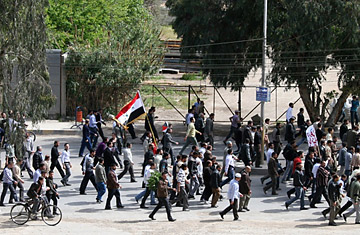
Syrian antigovernment protesters march near Damascus on Friday, April 22, 2011
(2 of 2)
It's unclear what more Assad can do to mollify the protesters. He has tried conciliatory measures, rescinding the country's 48-year-old emergency law and abolishing the Supreme State Security Court on April 21, as well as granting citizenship to stateless Kurds. As Syria's absolute ruler, Assad has sacked his largely ceremonial government, appointed another and also named new governors for Dara'a and Homs. Yet the moves have failed to defuse mass discontent.
Assad has also tried ruthless tactics from his father's bloody playbook. He has sent in security forces to seal off major cities, including the coastal city of Latakia as well as Dara'a, and met protesters with tanks, live ammunition and heavily armed riot police and soldiers in confrontations that have, so far, left at least 200 dead, according to Syrian human-rights activists. On the night of April 21, the President deployed the military in Homs and Damascus. Still, the protesters remain on the streets, and in ever greater numbers.
Mazen Darwish, a rights activist who has been detained by security forces twice since the unrest began, says the President still has an opportunity to "liberate" himself from his Baathist regime. Once quite popular, the President has lost support in recent weeks, largely because of the deaths of protesters. Still, many Syrians draw a line between him and more-despised elements of the regime. "The issue isn't a dispute about the President himself. It's about a system that many people feel can't go on in its present form," Darwish told TIME by telephone from Damascus. "What we're asking for is that he personally transition the country to democracy and spare Syria the unrest that nobody wants. He should provide a clear program for real reforms that will make the country a modern, free democracy. This request is part of his responsibilities as a President."
For Assad, however, giving in to protesters' demands may be worse than standing his ground. It would make him look weak in the eyes of important elements of the regime. Tunisia's President Zine El Abidine Ben Ali sounded his regime's death knell when he told demonstrators that he had "understood" them, before rattling off a laundry list of reforms that were too little, too late. Appeasing protesters by issuing piecemeal concessions also didn't work for Egypt's Hosni Mubarak, a pharaonic President who seemed as immovable as the pyramids yet was ousted in just 18 days. At the other end of the spectrum, brute force hasn't subdued Libyan leader Muammar Gaddafi's foes, despite a death toll some believe to be in the thousands and the use of tanks and mortars against poorly armed and barely trained rebels (who are, however, supported by Western fighter jets).
So what's Assad to do? "Frankly, I think we're in for very difficult times," a prominent Syrian analyst told TIME from Damascus on condition of anonymity. "I think they need to go full bore with the changes. They need to be 10 steps ahead of what everybody expects."
So far, the regime appears to be 10 steps behind public demands. Many analysts concede that if the President's second speech since the unrest began — in which he spoke of reforms, including doing away with the dreaded emergency law, and expressed sympathy for the deaths of "martyrs" during the protests, both civilian and uniformed — had been his first speech, he might not have needed a second. Assad must make grand reform gestures, says the analyst, who is close to the regime, and he must do it now. "There's no other option," he says. "Shooting at people is not going to work."
